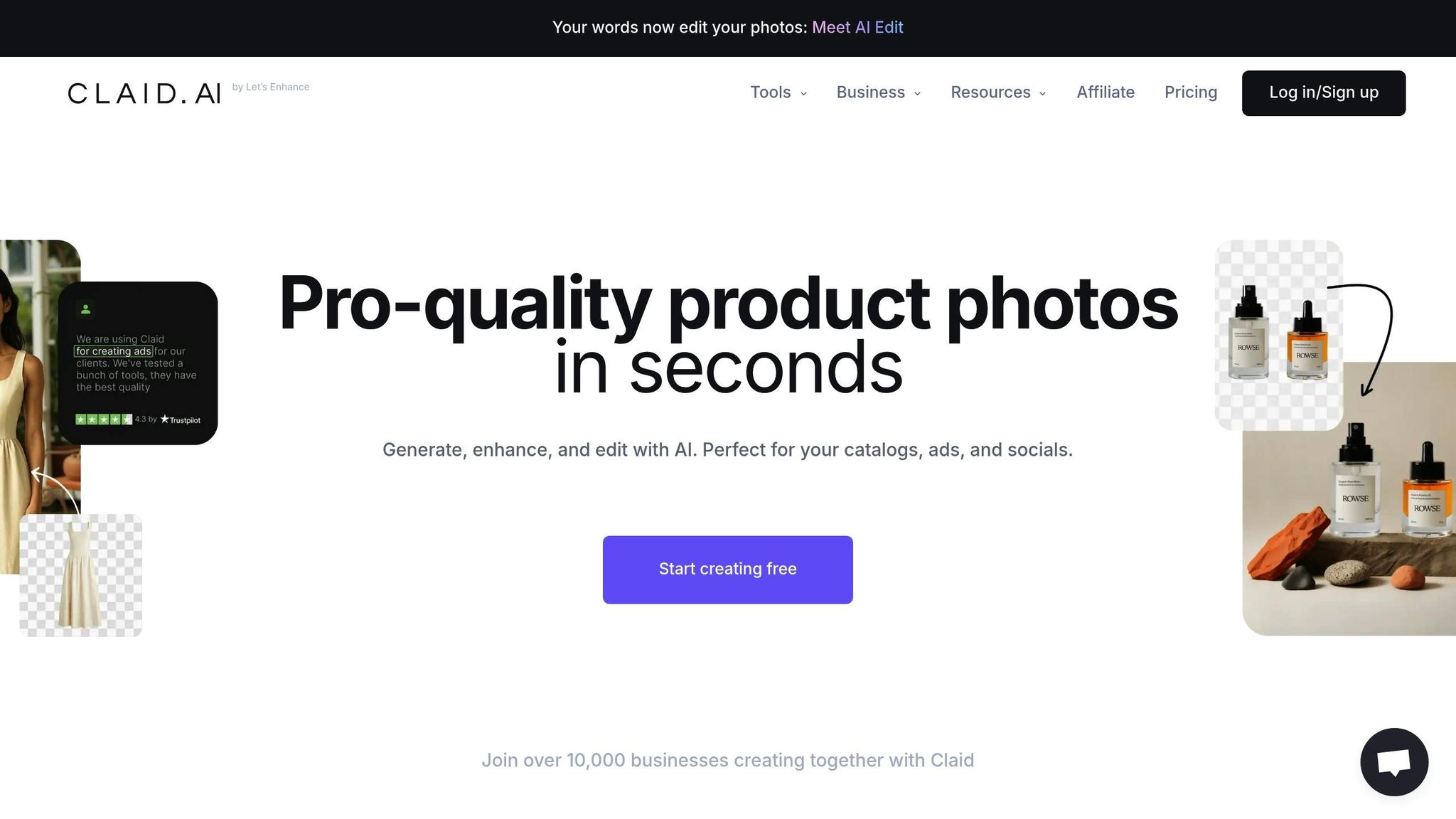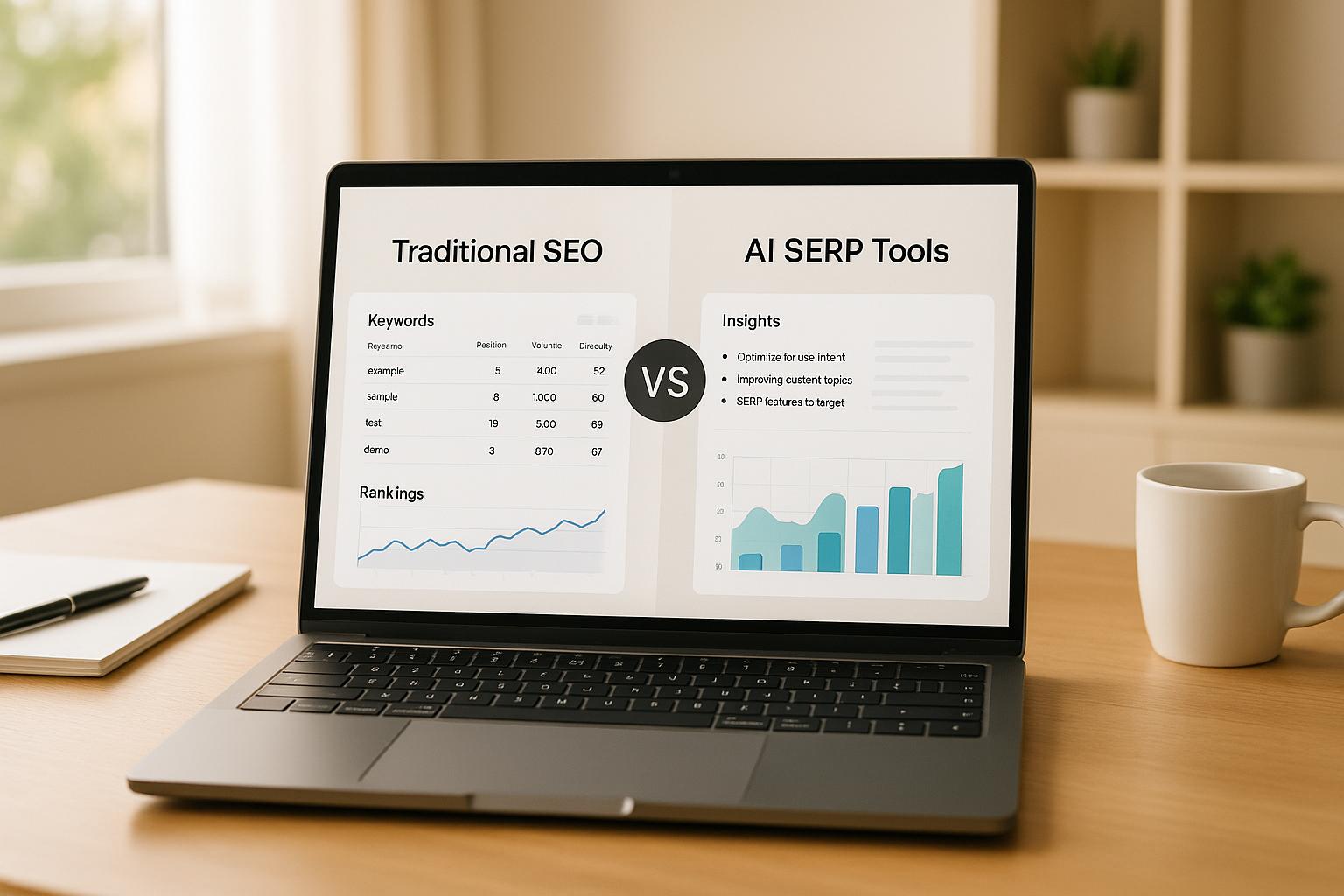When deciding between Claid.ai and Canva for your business, the choice boils down to your specific needs:
- Claid.ai is tailored for businesses that need high-quality product photo editing. It's ideal for e-commerce stores, offering automated tools like AI background removal, product placement, and lifestyle shot creation. Pricing starts at $19/month, based on usage.
- Canva is a versatile design platform best for creating marketing materials like social media posts, presentations, and ads. It offers extensive templates and collaboration tools for teams. Canva Pro costs $118/year per user.
Key Takeaways:
- Choose Claid.ai for bulk product photo editing and automation.
- Opt for Canva for diverse design needs and team collaboration.
- For businesses with both needs, using both tools together can be a practical solution.
Quick Comparison:
| Feature | Claid.ai | Canva |
|---|---|---|
| Focus | Product photo editing | Marketing and design |
| Best For | E-commerce stores | Marketing teams |
| AI Tools | Background removal, AI photoshoots | Text-to-image, Magic Design |
| Collaboration | Basic sharing | Real-time team collaboration |
| Pricing | Starts at $19/month | $118/year per user |
Pick the tool that aligns with your workflow, or combine both for maximum efficiency.
Claid.ai vs Canva – Which Tool Is Better for E-commerce Product Photos?

Big Differences Between Claid.ai and Canva for Work Use
The main thing that sets Claid.ai and Canva apart is their focus. Claid.ai is made just for editing product pictures, making it the top pick for e-commerce work. On the other hand, Canva gives you a wide set of tools for making all sorts of marketing stuff. Let's look at what each tool offers and when to use them.
Claid.ai: Made for Product Picture Editing
Claid.ai is made with e-commerce in mind, making it easy to edit product photos. Its best part is the Custom AI, which can make real-looking lifestyle shots and fake fashion models - great for online shops and product books.
A big plus for Claid.ai is its API for big jobs. This part is a big deal for firms that handle lots of product pictures, letting them do repeated jobs fast. Also, Claid.ai gives tools like AI-run background making and real product setting. These help turn simple product photos into clean, pro book images with little work.
Canva: All-around Marketing and Design Tool
Canva is best for making a mix of marketing things. Its big template book and AI parts, like Magic Design and text-to-image making, make it easy to make good visuals - even for those with no design skill. Canva also lets users cut or swap items in designs, adding more ways to change things.
For teams, Canva is strong on working together. Its tools keep brand look the same across different spots while letting many users work on marketing goods at the same time. Whether it’s for social media pics, talks, or booklets, Canva makes it easy to make pro-looking designs.
Picking the Right Tool for Your Work Needs
Choose Claid.ai if your firm needs top-quality product pictures. For online shops or firms with big product books, Claid.ai’s power to make picture better fast can save time and really help sales.
Pick Canva if your main job is making lots of different marketing stuff. If you’re making posts for social media, booklets, or talks, Canva’s templates and team tools make it a great pick for lots of design work.
In some cases, using both tools can be smart. Claid.ai can make your product pictures better, while Canva can help you make the marketing stuff to show them off. The key is knowing which tool fits your work flow best.
How Business Tools Compare in Handling Workflows
When dealing with business tasks, Claid.ai and Canva pick different paths. Each tool is made with unique strong points for certain needs. Let’s look at their features side by side.
Editing Product Photos
Claid.ai stands out in editing product photos. It boosts photos to a large 559 MP, giving clear prints at 300 DPI in just 2–3 seconds each. With online sales in mind, Claid.ai is good at cleaning up back scenes and fixing light. It has a solid record in this area.
In contrast, Canva aims at wider design work rather than just product photos. While Canva can do simple edits like taking out backgrounds and fixing colors, it misses the detailed tools for product shots that Claid.ai has. Canva is better at making various marketing items, like posts for social media and ads.
AI Features for Creating Content
Since 2018, Claid.ai has focused on making AI that creates content. For instance, its Custom AI can turn simple product photos into more life-like images, cutting out costly photo events. Its AI Photoshoot goes further, turning one product shot into many scenes and settings. Users of these tools report saving up to 90% on photo costs.
On the other hand, Canva uses its AI for general design work. It is great for making things like social media posts and marketing images, but not as sharp for product shots as Claid.ai’s tools.
Automation and Handling Lots of Images
For businesses dealing with many photos, Claid.ai changes the game. Its API lets businesses automate handling lots of images at once, saving time and making tasks easier. For example, Rappi cut editing time by 42% and seller time by 28% using Claid.ai. They also got 33% more restaurants to join them. Claid.ai is also cheaper - it edits photos at a cost five times less than usual services, great for firms with big photo needs.
However, Canva stresses on team work. Its platform lets more than one person work on projects while keeping the style the same. This group way is good for teams making different content but doesn't fit well with the automated, big image handling often needed by online stores.
Cost and Worth for U.S. Companies
To pick the best tool, U.S. firms need to know the price plan well. This helps them fit it into their budget and specific wants. Now, let's look at how Claid.ai and Canva stack up in terms of price and value.
Claid.ai's Pricing and Business Offers
Claid.ai has a credit-based system, where firms pay based on what they use, not a set fee each month. This setup works well for firms that have changing needs for image work.
- Free Trial: Includes 5 uploads and 50 API credits, lets firms try Pro features at no cost.
- Essentials Plan: Costs $19/month or $180 a year (like $15/month) and gives 200 credits; suits solo entrepreneurs and small firms.
- Professional Plan: Costs $49/month or $468 a year (like $39/month); this plan has 1,000 credits, custom templates, and support for big images (up to 64 MP uploads and 128 MP downloads). Great for growing small to medium firms.
- Custom Business Plans: Special pricing for big firms, has advanced API setups, top support, and early tool access.
Credit costs vary by the task. For example:
- Light and color tweaks take 1 credit per image.
- Removing backgrounds takes 2 credits.
- AI Photoshoot needs 3 credits.
Firms needing more credits can buy 1,000 for $59.
Canva's Pricing for Teams and Design Jobs
Canva uses a standard sub plan with prices per user. This is good for teams making lots of different marketing pieces, from social media to slides. Once in, users can make endless designs without worrying about image costs. It fits well for teams making diverse content more than lots of automated images.
Cost Check for Small to Medium Firms
For firms processing under 200 images a month, Claid.ai’s Essentials plan is a cheap option at about $0.10 per image. This beats traditional editing services that often charge $50 to $150 per image.
Mid-sized firms with more images get better value from Claid.ai’s flexible credit system. By 2025, it’s seen that 76% of small firms using AI photo tools will cut editing costs by over 80%.
The choice depends on the firm’s flow. E-commerce firms with lots of product photos each month often do better with Claid.ai’s credit system. It’s very useful for handling up to 75% of image tasks for Shopify shops. Yet, marketing teams needing different design styles might prefer Canva’s sub model, which lets them make lots of designs but lacks the special product photo editing Claid.ai offers.
For firms with big product lists, Claid.ai's group work tools and API flows give good, steady results. They also save a lot of time and money over old edit ways. Picking one over the other turns on if a firm values fast, auto image edits or flexible design uses for ad tasks.
sbb-itb-212c9ea
How Using Claid.ai and Canva Makes Money
Real-life examples show that Claid.ai and Canva both provide real gains. Each shines in ways made for what a business needs.
For Online Store Catalogs
Claid.ai helps web stores handle lots of product pics. It makes it easy to fix product photos by doing things like fixing light, cutting out backgrounds, and keeping the brand look the same. This all leads to a clean, pro look over all products, which makes customers trust more and keeps the brand image the same.
For things like clothes and electronics, where Claid.ai takes out backgrounds on its own, it's very helpful. Not needing a person to edit saves money, while keeping a high, even quality in pictures.
Better pics - clearer detail, improved light, and even looks - may also make more people care, drawing them to your items in busy web stores.
While Claid.ai is all about making product pics better, Canva aims to boost marketing and keep brand looks the same.
For Marketing and Brand Work
Canva does great in team marketing jobs where different stuff needs to be made fast. Its ready-to-use designs make running many jobs at once easy, helping marketing groups keep a clear brand look over social media, emails, slides, and more.
The tool makes it simple to change designs for different spots, making sure the brand looks the same everywhere. This clear brand voice is key to making a strong stand in the market.
Canva's shared brand kits are a top pick. They bring logos, colors, and fonts together so teams can make sure all materials match the brand rules. This keeps the brand known and powerful in the market.
Time Saved and Better Workflow
Both tools boost ROI by making things more efficient in different ways. Claid.ai is all about quick editing for many images, letting teams focus on things like talking to customers or making plans.
Claid.ai also makes steps quicker by fixing images right when they are put in the catalog. This cuts down on needing a person to check and keeps images looking the same, cutting mistakes and saving time.
Canva, though, betters team work by making the design OK process more simple. Instead of long email talks, teams can write notes right on the designs and say yes to final looks there. This cuts wait times and forgets mix-ups.
Both have lots of design setups ready, saving time on getting projects ready. Claid.ai offers setups for product pics to keep the look the same, while Canva has a big mix of marketing setups to quicken campaign making.
While Claid.ai is easy to use right off, Canva might need some learning for teams to use it fully. But, firms often see work getting better soon after they start using any tool, as both fit well into how the work is already done.
Look, Cost, and Worth
This part looks at the main things that set Claid.ai and Canva apart, like what they can do, how much they cost, and their total worth. Use this info to pick which tool fits your work and aims best.
List of What Each Can Do
Here's a view of their skills right next to each other, and how they help your work:
| Key Point | Claid.ai | Canva | Impact on Business |
|---|---|---|---|
| Remove Background | AI does it on its own | Need to work it by hand with Magic Eraser | Makes photo editing fast |
| Edit Many Images | Good for many photos | Can edit lots, but with some limits | Great for online shops with lots of images to handle |
| Image Setups | Focus on product pics | All kinds of marketing setups | Canva fits many project types |
| Brand Kit Storage | Basic asset storage | Full system to keep brand rules | Keeps look the same across team |
| API Setup | Strong API for automating | Basic API stuff | Makes working with online shop platforms easy |
| Video Cuts | None | Some video tools | Canva lets you work on more types of stuff |
| Work Together Tools | Basic sharing to get | Help from team in real-time | Best for teams who need constant input and changes |
| Generate Content | Focus on making images better | AI helps with text, graphics, layouts | Canva helps more with varied creative tasks |
This chart shows how the parts of each tool fit with different work needs, like online selling, ads, and group work.
Cost and Worth Overview
Here's a look at how their price plans compare:
| Plan Type | Claid.ai | Canva | Best For |
|---|---|---|---|
| Free Tier | Few image edits for tests | Few templates and storage | Small works and first try |
| Basic Plan | Fits mid-range image tasks | Cost by user for small groups | Small firms |
| Professional | Made for bigger firms with more images | Paid per user for many design jobs | Firms getting bigger |
| Enterprise | Set cost for lots of work | Plans for big group needs | Big groups and big places |
Claid.ai's cost plan ties to how many images are used, which helps businesses that deal a lot with product photos know what to expect. Canva, on a different note, sets the price per person, giving flexibility to groups that handle many kinds of content. Each price model meets different needs, from heavy image editing to a wider plan for creating.
Method Note
These notes use info anyone can find. To get the freshest and right details, think about trying free versions or talking to sales people. Remember, what you can do and how much it costs can change based on the plan you pick. Big business deals may also have special price setups.
Picking the Best Tool for Your Business
Choosing the right tool for your business means knowing how you work and what you want to do. Different tools are good at different things, so pick one that fits what you need. Here, we list the best choices for common business tasks.
High-Number E-Commerce Tasks
Use Claid.ai if your business deals with lots of product photos. It does not matter if you have a small Shopify shop or a big e-commerce site; Claid.ai is made to handle a lot at once.
Claid.ai’s API system can work with thousands of photos at the same time, making it great for businesses that need a lot of editing. It sets up padding and lines up things to meet marketplace needs on its own, saving you time on doing it yourself. Also, Claid.ai has top features like AI-made backgrounds and fake model creation, which can make your products look better.
The price is simple - Claid.ai charges by how many images you use, not how big your team is, as shown in the pricing section. But remember, Claid.ai only focuses on product photos. If you also need tools for making social media pictures, email tops, or other marketing stuff, you might need another tool too.
Content Marketing and Branding Needs
Go for Canva if your team makes different marketing stuff and likes to work together. Canva is great for teams that need to make and okay designs fast.
Canva has lots of templates and design pieces, great for making things from Instagram posts to business slides. It charges per user, which helps teams work together better, and its brand kit system keeps a steady style across all your stuff. But Canva's photo tools are simple, so if your marketing needs detailed product pictures, it may not do well there.
Using Both Tools Together
For businesses that need top photo editing and wide design choices, using Claid.ai and Canva could be the best way. This lets you use Claid.ai for things like taking backgrounds out and making lifestyle photos, while Canva manages the design of ads, social media, and promo stuff.
This two-tool way is very good for e-commerce brands on many platforms. You can have nice, finished product photos for your site and markets while also making lively stuff for social media and email ads. Mixing Claid.ai's needed plan with Canva's basic plan gives a good price to meet all your needs.
If your business needs both a lot of photo editing and strong content marketing, this mix can save a lot of time and work. By using each tool for what it does best, you can make your work flow better and up your results, making the extra subscription costs worth it.
Final Words: Choosing the Best AI Tool for Your Business
To pick the right AI tool, think about what your business needs most. This choice can save you time and money.
For online shops, Claid.ai stands out when you need many high-quality product photos edited fast. It's very good at making images look professional which is helpful for product pages and online sales. It has good prices, making it a wise pick for dealing with lots of pictures. On the other hand, Canva works best for teams making different kinds of marketing stuff. It has many templates and tools that work well for making social media posts, slides, and other things. Knowing what each tool does best makes it easy to choose the right one for your needs.
Online stores will find Claid.ai’s editing tools very useful, while businesses focused on services or content will get more from Canva's wide design options.
However, many businesses might do well using both tools together. For instance, an online shop that also does a lot of social media might use Claid.ai for product photos and Canva to make cool marketing stuff. Using both tools together can help cover all needs.
Start with the main tool you need and think about the second one only if it helps more. Both Claid.ai and Canva let you try them for free, so use those trials to see how they work for real tasks in your business.
FAQs
How do Claid.ai and Canva differ in features and who they’re best suited for?
Claid.ai specializes in AI-driven image editing tools designed with businesses in mind, particularly those in e-commerce. Its strengths lie in features like background removal, image upscaling, and producing high-quality visuals tailored for product photography. Canva, by contrast, is a multi-purpose design platform that offers templates, drag-and-drop functionality, and AI-powered content creation. It caters to a diverse audience, including small businesses, educators, and individuals.
If your goal is precise image refinement, Claid.ai is a great fit. However, if you’re looking to create marketing materials, branding assets, or other design-focused projects, Canva’s broader design capabilities make it the better choice. The decision ultimately hinges on whether you prioritize specialized image editing or versatile design tools.
How can businesses choose between Claid.ai and Canva, or use both effectively?
To choose between Claid.ai and Canva, businesses need to pinpoint their specific visual content goals. Canva shines when it comes to crafting versatile designs, branding materials, and marketing assets, thanks to its user-friendly interface and AI-driven tools. Meanwhile, Claid.ai focuses on refining product images through features like background removal, upscaling, and optimization tailored for eCommerce or catalog needs.
Many businesses benefit from combining both platforms. Canva excels in creative design and branding, while Claid.ai ensures product images look polished and professional. Together, they deliver a well-rounded solution for a variety of visual content demands.
How do the pricing options for Claid.ai and Canva compare, and which is better for small to medium-sized businesses?
Claid.ai operates on a credit-based pricing model, starting at $9 per month. This includes unlimited image enhancements and access to templates. API credits are priced between $0.05 and $0.06 each, depending on the chosen plan. While this setup can be a cost-efficient option for businesses with specific, task-focused needs, it does require close monitoring to avoid exceeding budget limits.
Canva, on the other hand, uses a subscription-based pricing system. Its Pro plan costs $120 per year per user, while Teams plans start at $8.33 per month per person. These options are well-suited for collaborative teams, offering predictable expenses that make budgeting straightforward.
For small to medium-sized businesses, Claid.ai works well for targeted, task-driven projects. Canva’s tiered subscriptions, however, are a better fit for ongoing, team-based efforts.



